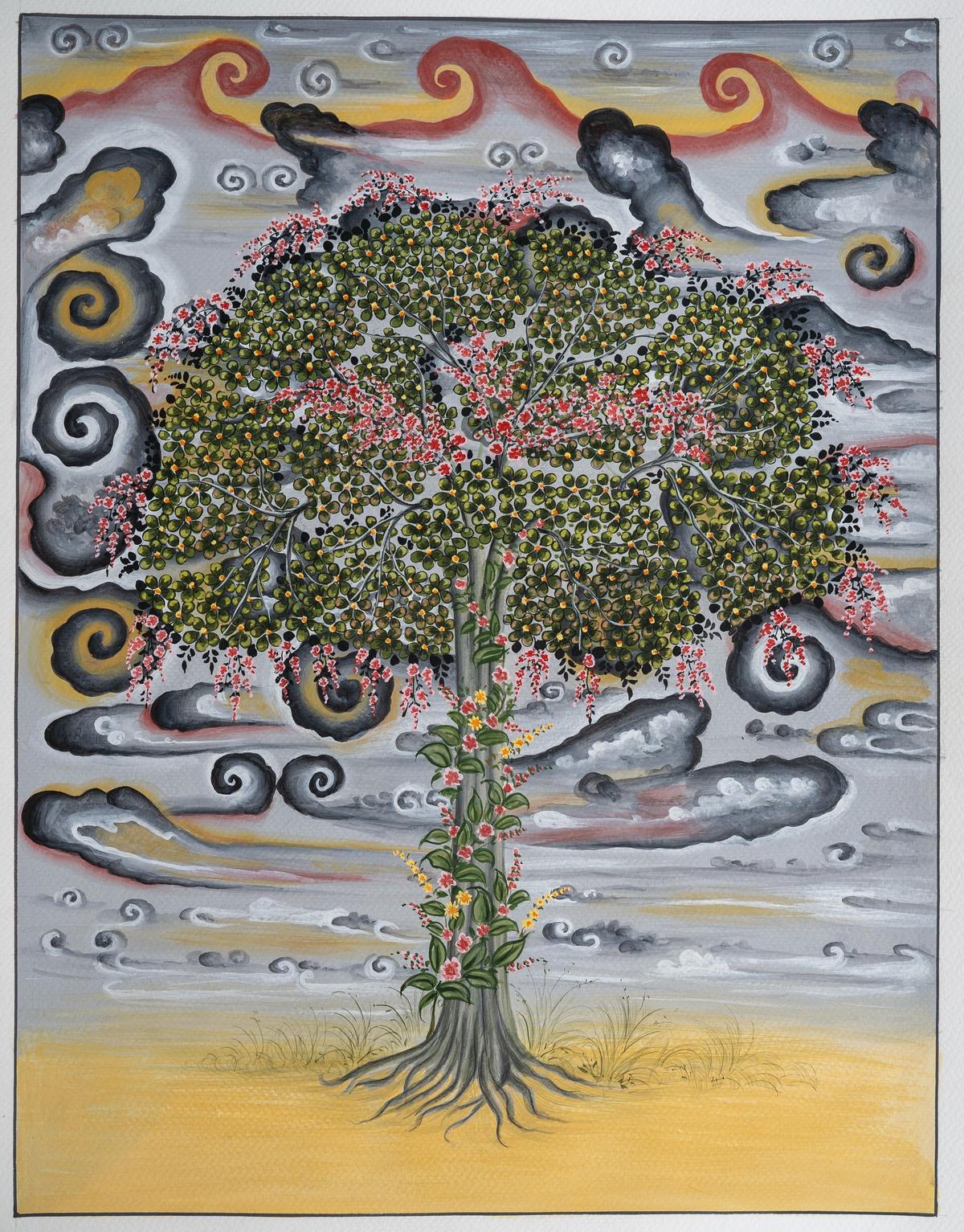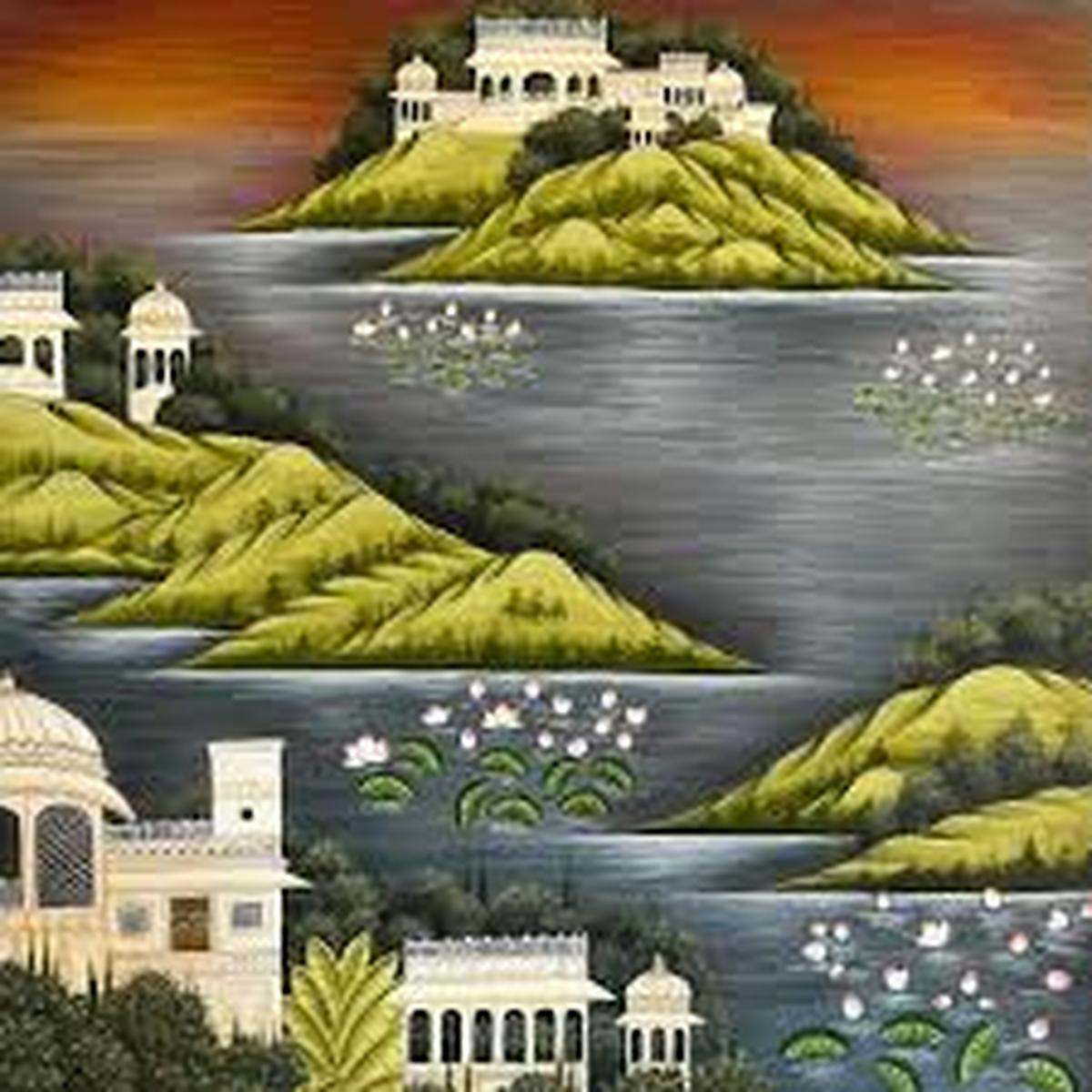Almond-shaped eyes, aquiline features, elongated faces with defined chins and noses, earthy tones, panoramic landscapes and stylised clouds — these are some of the things that set apart Kishangarh paintings from the other miniature traditions of India.
Drenched in bhakti and sringara rasas, these miniatures originated somewhere around the 17th Century in Kishangarh in Ajmer, Rajasthan. Rulers such as Raj Singh and Sawant Singh set up court ateliers led by Bhavanidas and Nihal Chand and patronised this art form. However, diminished patronage over the years has seen miniatures and traditional visual art forms relegated to the realm of handicraft.
From Vaishnavi Kumari’s Kishangarh Studio
| Photo Credit:
Courtesy: Kishangarh Studio
Centuries later, Vaishnavi Kumari, who traces her lineage to the erstwhile royal family of Kishangarh, has taken upon herself the task of reinventing the art form to suit the contemporary milieu. In 2010, she set up Studio Kishangarh, where she works with artists to create paintings that merged traditional aesthetics and modern sensibilities.
“We do acrylic on canvas, work on wasli (handmade) paper and take up landscape themes. We might take inspiration from a Pichwai painting and interpret it in our own way, using gold and silver embellishment. We recently had a show ‘Ishq Chaman’ based on the poetry of Raja Sawant Singh. The poem talks about devotion and we created allegorical paintings on love and devotion for god,” says Vaishnavi Kumari, the curator and founder of Studio Kishangarh.
Vaishnavi graduated from NIFT and pursued her Master’s in art history from SOAS University, London. “Middlemen buy unique haathi-ghoda paintings at very low prices from artists. These are sold as souvenirs. That set me thinking. In museums and auctions, you see work that is highly valued, and I wondered why we were not producing that kind of quality. Traditionally, a patron influenced the kind of work done in karkhanas (workshops). For example, you see hunting scenes in Kota paintings, because the ruler wanted those depictions. Nainsukh (1710-1778) painted most of his works for the local ruler Raja Balwant Singh of Jasrota in Himachal Pradesh. That encouraged me to set up an atelier and offer contemporary patronage,” says Vaishnavi.
A Kishangarh miniature
| Photo Credit:
Courtesy: Kishangarh Studio
A couple’s rendezvous in a lush green garden against the picturesque backdrop of mountains, dense flora and fauna and a distinct blue sky is an aesthetic marvel, and a typical Kishangarh miniature. This style is also synonymous with Bani Thani — known as the Indian Mona Lisa, a combination of grace and beauty, supposedly painted by Nihal Chand, as instructed by then ruler Raja Sawant Singh. It is said that the Raja and Bani Thani were lovers, and they are the nayak and nayika in several paintings.
Among the most famous of Kishangarh paintings, ‘Boat of Love’, is on display at the National Museum, Delhi. Inspired by Raja Sawant Singh’s poem, the painting depicts three scenes featuring Radha and Krishna — atop a hill, crossing the river seated on a boat accompanied by attendants, and amid dense foliage.
Through her work in the atelier with her artists, Vaishnavi wants to educate people about the art tradition. “What you see is just the first layer which is the aesthetic — the women are beautiful, the figures so lyrical… but there is a deeper meaning. Bani Thani wasn’t just a beautiful woman. She was an accomplished poet and an amazing musician. Sufism and Haveli Sangeet were major influences at the time and we want the viewers to discover all these facets to these paintings. Raja Sawant Singh was a Bhakti poet and wrote in Rekhta, a precursor to the Hindustani dialect, among other languages, under the pen name of Nagari Das. A pushtimargi, belonging to the Vallabhacharya sect, he wrote devotional poetry for Krishna and Bani Thani,” she adds.
Kishangarh miniature
| Photo Credit:
Special Arrangement
Once Vaishnavi returned from London, she discovered many families that had been painting for generations. She brought together a few of them for two reasons — better livelihood opportunities and the chance to develop a unique aesthetic.
“We have a core group but we also work with other artists. When we started, we were doing handicrafts — we painted apparel. I explore a lot of media. Even though I give ideas, the exploration is by the artists. Also, each painting is the collective work of two or three artists — one does the basic drawing, the other adds the flora and fauna elements, the third might add an iconic element like the Kamadhenu. They enjoy working on a new visual vocabulary,” says Vaishnavi, who is trying to strike a balance between the old and the new.
Vaishnavi Kumari, who traces her lineage to the erstwhile royal family of Kishangarh, has taken upon herself the task of reinventing the art form to suit the contemporary milieu
Published – April 24, 2025 06:10 pm IST





































